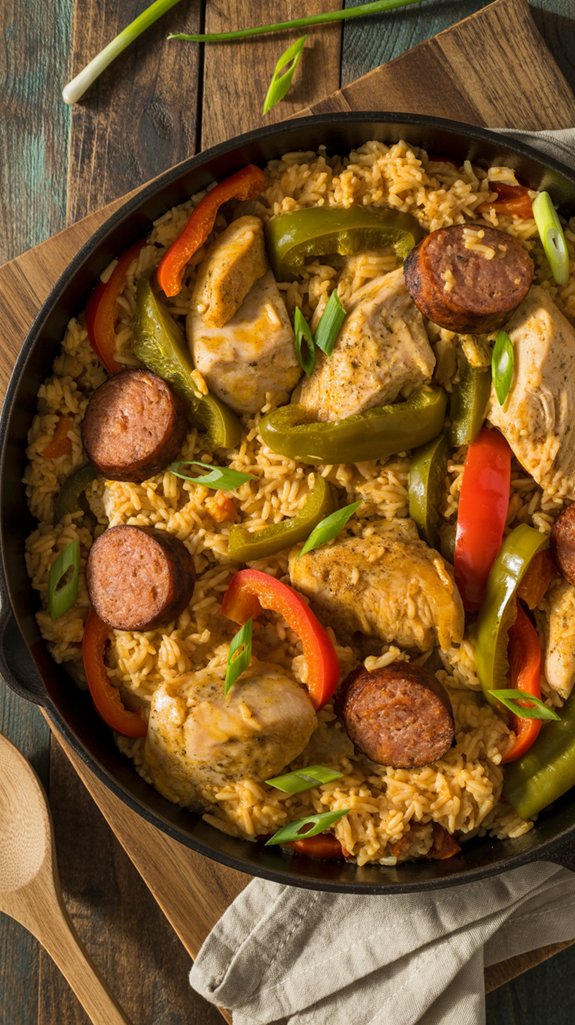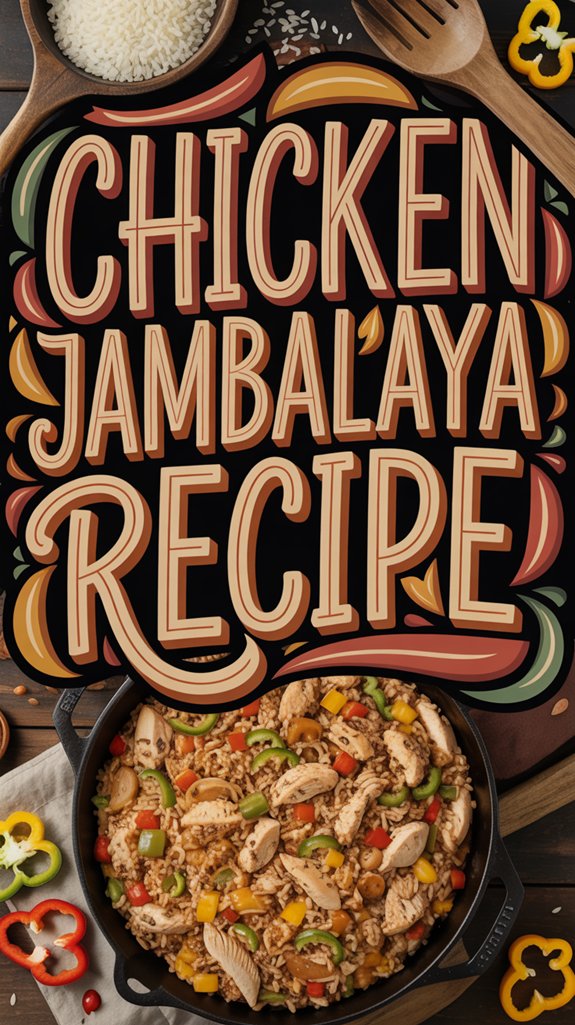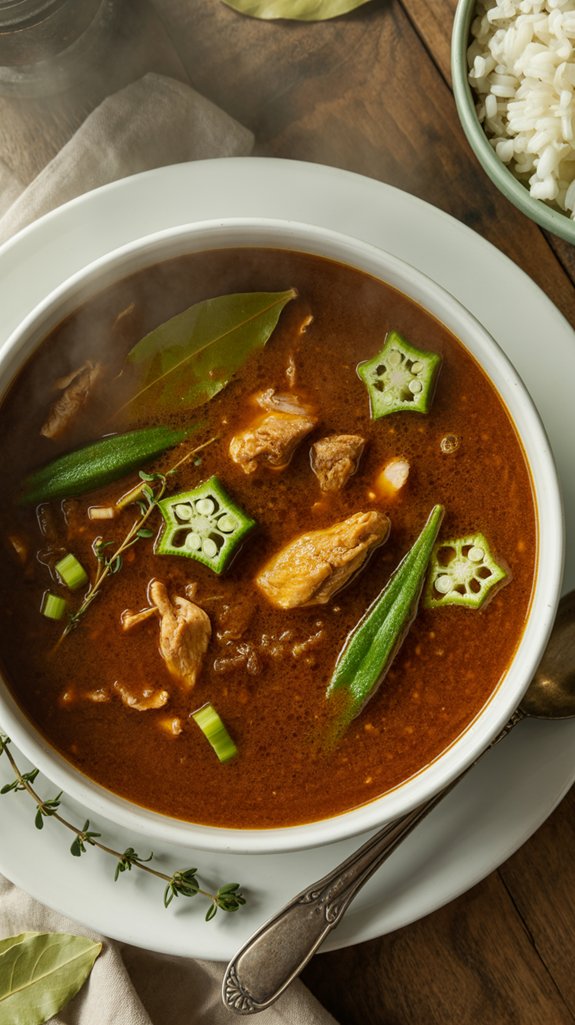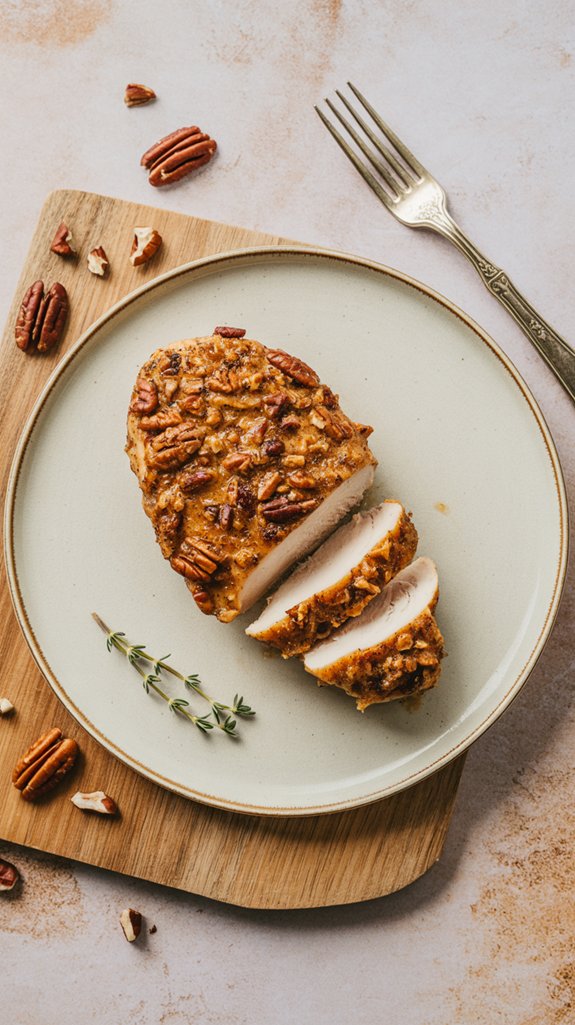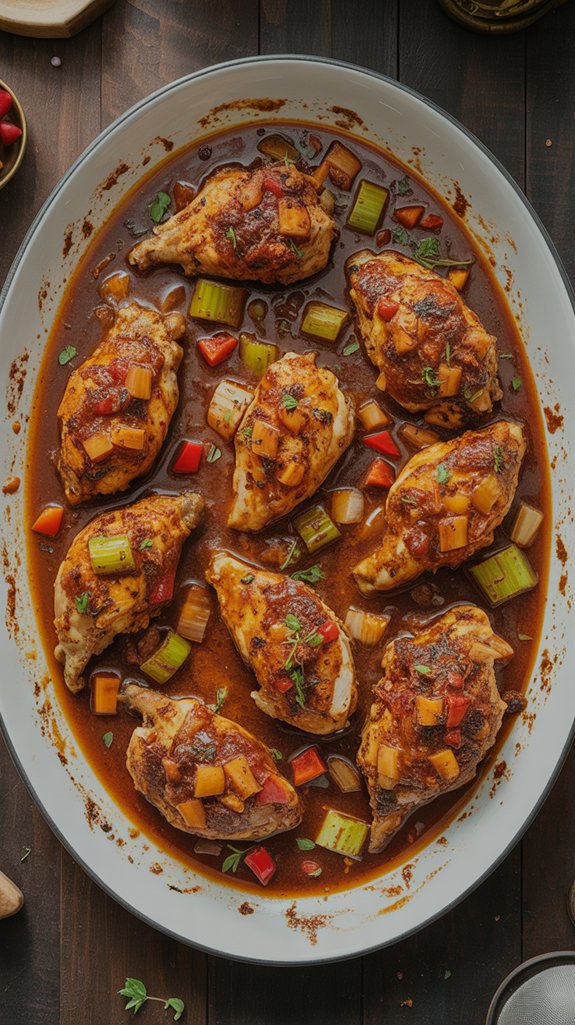Why You’ll Love This this Chicken Jambalaya
This chicken jambalaya brings together tender chicken, smoky sausage, and plump shrimp in one incredible pot that’ll have your kitchen smelling like a Louisiana dream.
You get that perfect balance of hearty protein, fluffy rice, and vegetables all mingling together with just the right kick of spice – though honestly, who doesn’t love a dish where you can adjust the heat to your heart’s content.
The best part is watching everything come together in that beautiful, messy harmony that only happens when you let good ingredients do their thing, creating a meal that’s fancy enough for company but simple enough for a Tuesday night when you’re craving something special.
Ingredients List
This chicken jambalaya calls for a beautiful mix of proteins, vegetables, and pantry staples that work together to create something truly magical in your kitchen.
- 1 whole chicken (3-4 pounds)
- 1/2 teaspoon salt (for cooking chicken)
- 1/4 teaspoon pepper
- 4 tablespoons bacon fat
- 4 tablespoons flour
- 1 pound smoked sausage, sliced into 1/2 inch pieces
- 2 medium onions
- 1 green pepper
- 1 red pepper
- 1 yellow pepper
- 6 cups diced tomatoes
- 1 clove garlic
- 1/4 cup chopped parsley
- 1/3 cup green onion
- 3 cups chicken broth (reserved from cooking chicken)
- 1/4 teaspoon thyme
- 1/2 teaspoon cumin
- 1/2 teaspoon salt
- 1/2 teaspoon liquid red pepper seasoning
- 2 cups long grain rice (uncooked)
- 1 pound fresh shrimp, deveined and shelled
Ingredient Considerations:
- This recipe packs plenty of protein from three different sources, giving you a hearty meal that’ll keep you satisfied
- The bacon fat adds incredible flavor but you could substitute with olive oil if you’re watching saturated fat
- Fresh vegetables bring vitamins and fiber to balance out all that delicious protein
- Using homemade chicken broth means you control the sodium content, unlike store-bought versions
- The rice provides complex carbohydrates for sustained energy, making this a well-rounded one-pot meal
Step by Step Directions
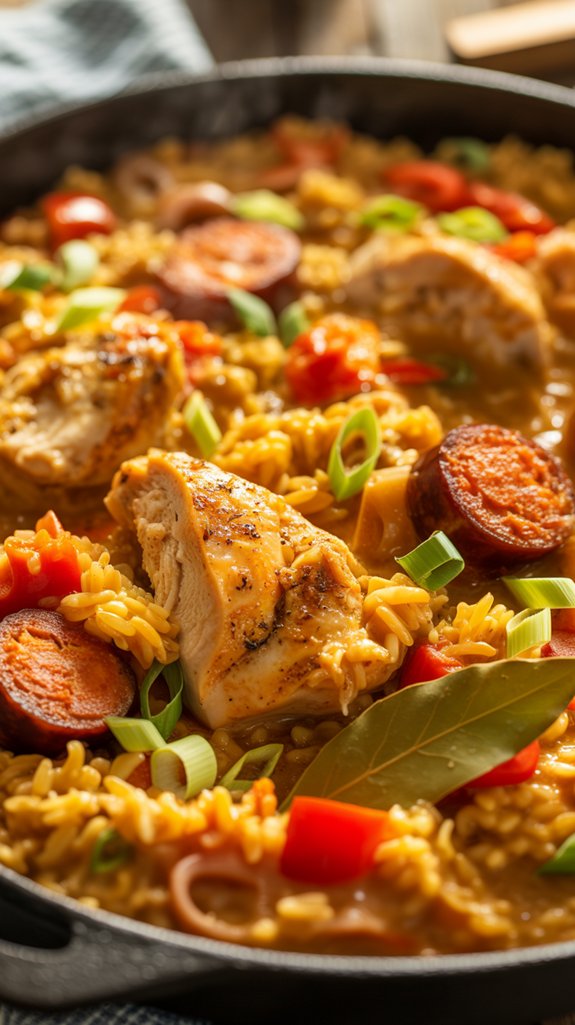
This traditional chicken jambalaya builds layers of flavor through careful preparation of each component before bringing everything together in one magnificent pot.
- Prepare the chicken base: Clean and place chicken with 1/2 teaspoon salt in a 6-quart stock pot, cooking until well done.
- Prep remaining ingredients: While chicken cooks, clean and chop all vegetables, slice smoked sausage into 1/2-inch pieces, and prepare shrimp.
- Process the cooked chicken: Remove chicken from pot, allow to cool, then remove meat from bones and cut into small pieces.
- Prepare the broth: Strain chicken broth and reserve 3 cups, allowing it to cool enough to skim fat from the top.
- Make the roux: Melt bacon grease in a large 16-quart stock pot, sprinkle flour over hot grease, and stir until roux begins to brown (avoid burning).
- Build the jambalaya base: Add chicken, reserved broth, vegetables, and sausage to the roux, mixing well.
- Season the mixture: Stir in thyme, salt, pepper, cumin, and hot sauce, mixing thoroughly.
- Add rice and cook: Stir in uncooked rice and bring to a boil.
- Finish with seafood: Add shrimp, parsley, and green onion, then simmer covered on low heat for approximately 15 minutes until rice is tender.
- Adjust consistency: Add tomato juice if the mixture appears too dry during cooking.
For restaurants serving this dish regularly, commercial pasta machines can help streamline kitchen operations by efficiently preparing fresh pasta sides to complement the jambalaya.
Substitutions and Variations
- Make it lighter: Turkey sausage cuts down on fat without sacrificing much flavor. You can reduce the bacon fat and use chicken broth for the roux base instead
- Vegetarian version: Impossible, you say? Plant-based sausage, mushrooms for that meaty texture, and vegetable broth create a surprisingly satisfying version that even meat-eaters might secretly enjoy
Additional Things to Serve With This Dish
This hearty jambalaya practically begs for some simple sides that won’t compete with all those bold flavors.
- Cornbread – The classic choice that soaks up every drop of that flavorful broth, and honestly, is there anything more satisfying than dunking warm cornbread into jambalaya?
- Simple green salad – Something crisp and fresh cuts through all that richness, maybe just lettuce, cucumber, and a light vinaigrette to cleanse your palate.
- Coleslaw – The cool, crunchy texture provides a nice contrast, plus it’s one of those make-ahead sides that actually gets better as it sits.
- Garlic bread – Because sometimes you need carbs on top of carbs, and that buttery garlic goodness pairs beautifully with the Cajun spices.
- Steamed broccoli or green beans – Your vegetables for the meal, keeping things simple so the jambalaya stays the star of the show.
- Pickled okra or jalapeños – These tangy little bites add extra zing and help cut through the richness, though fair warning, they might make things even spicier.
Cooking Tips & Tricks (Chef’s Notes)
Getting this jambalaya just right takes a little finesse, but these tips will help you nail it every single time.
- Don’t rush the roux – That flour and bacon fat mixture is doing serious work here, so stir constantly and let it get golden brown, not burnt black (trust me, burnt roux tastes like regret).
- Rice texture matters – Use long grain rice like the recipe says, never instant or short grain, because you want each grain separate and fluffy, not mushy jambalaya soup.
- Layer your proteins smartly – Add the shrimp last since it cooks in just a few minutes, while that chicken and sausage can handle the longer cooking time without turning to rubber.
- Taste as you go – Start with less hot sauce than you think you need, because you can always add more heat but you can’t take it back once it’s in there.
- Let it rest – After cooking, let the jambalaya sit covered for about 5 minutes off the heat, which helps the rice absorb any remaining liquid and firms up perfectly.
- Stock pot size really counts – Use that big 16-quart pot the recipe mentions, because jambalaya needs room to breathe and bubble without making a mess on your stovetop.
- Save some broth – Keep extra chicken broth on standby in case your rice drinks up more liquid than expected, because dry jambalaya is just sad rice with stuff in it.
Nutritional Facts
This hearty jambalaya packs serious flavor along with solid nutritional value, serving up a well-balanced mix of protein, carbs, and essential nutrients.
- Calories per serving: Approximately 485 calories (based on 10 servings)
- Protein powerhouse: About 32 grams of protein per serving from chicken, shrimp, and sausage
- Carbohydrates: 45 grams per serving, primarily from rice and vegetables
- Total fat: 18 grams per serving, with saturated fat around 6 grams from bacon fat and sausage
- Fiber content: 3 grams per serving from vegetables and rice
- Sodium levels: Approximately 850mg per serving (varies based on sausage and hot sauce used)
- Vitamin C boost: High content from bell peppers and tomatoes
- Iron rich: Good source from chicken, shrimp, and fortified rice
- B-vitamins: Excellent source of B6 and B12 from seafood and poultry
- Selenium: High levels from shrimp and chicken for antioxidant support
- Phosphorus: Good amounts for bone health from protein sources
- Cholesterol: About 95mg per serving from shrimp and chicken
Fun “Did You Know?”
While most people associate jambalaya with Louisiana’s bayous, the dish actually traces its roots back to Spanish paella, brought to New Orleans by Spanish colonists in the 18th century.
I find it fascinating that “jambalaya” likely comes from the Provençal word “jambalaia,” meaning mishmash or mix-up. The dish evolved as cultures blended – Spanish settlers adapted their paella using local ingredients like crawfish and andouille sausage.
There’s even a heated debate between Creole and Cajun versions: Creole jambalaya includes tomatoes (like our recipe), while Cajun purists insist tomatoes don’t belong. Both styles remain deliciously authentic.

